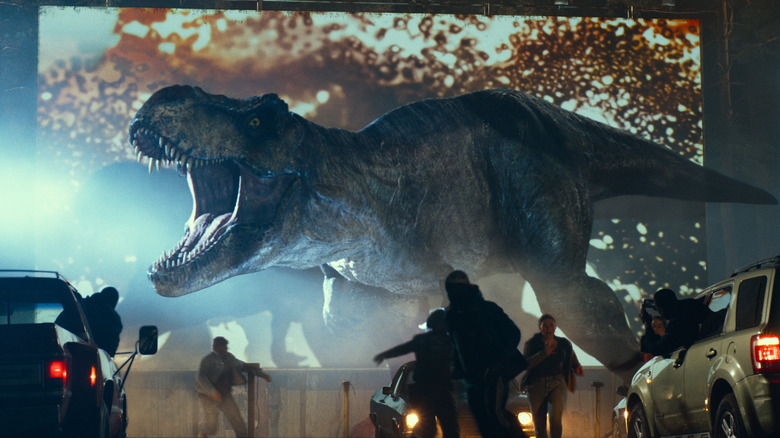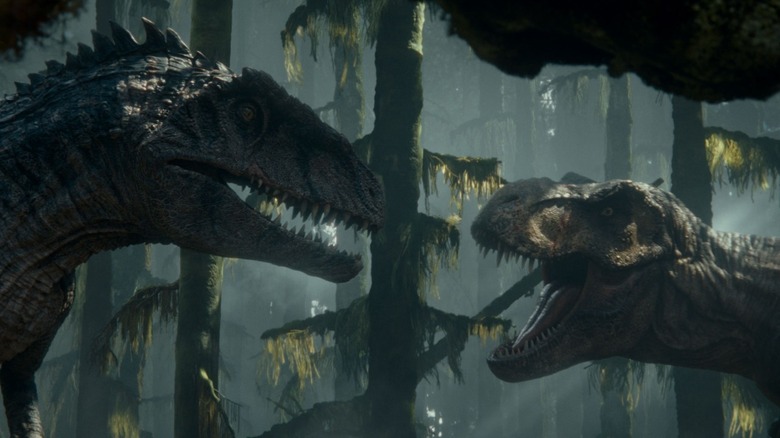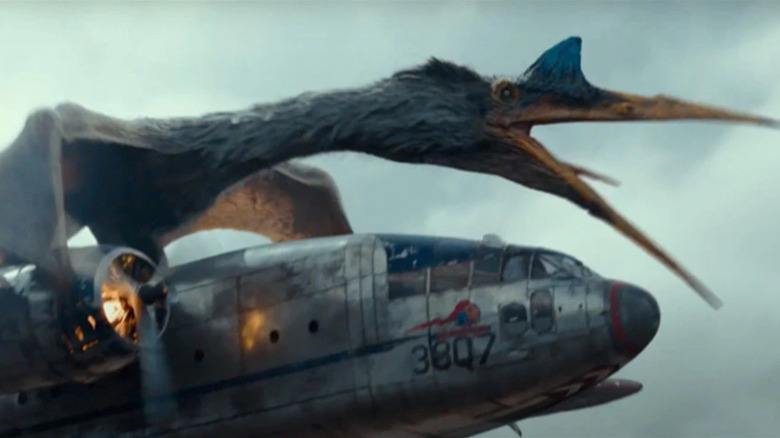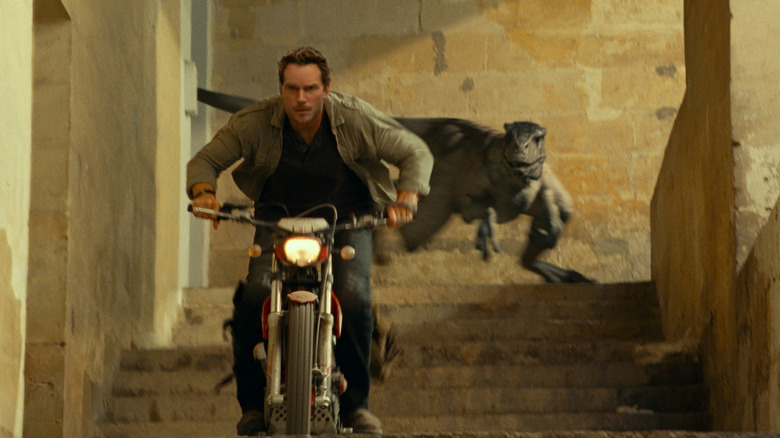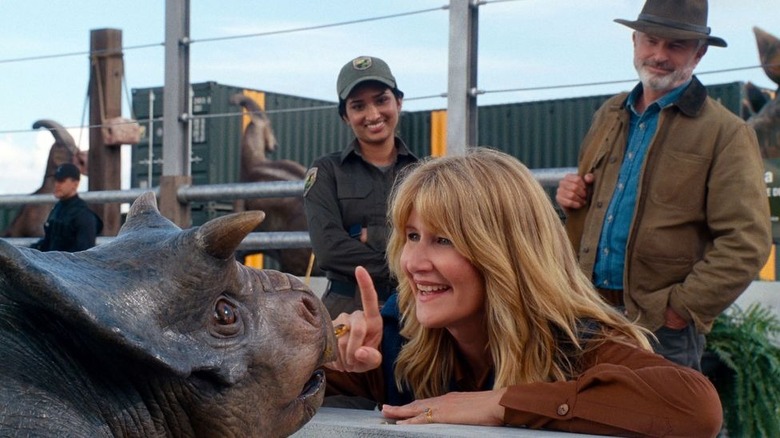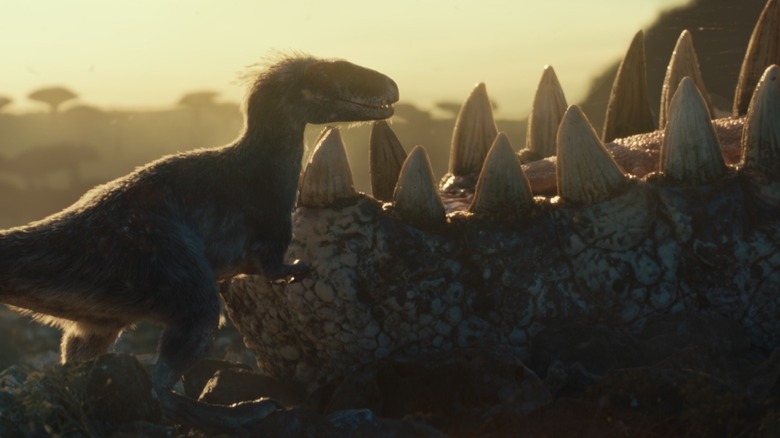Jurassic World Dominion VFX Supervisor Talks Combining Digital With Practical Effects And Putting Dinosaurs Into The Real World [Interview]
From the very beginning, the "Jurassic Park" franchise has promised audiences the alternately awe-inspiring and terrifying concept of bringing long-extinct dinosaurs into our present day. A primary task of the filmmakers behind the 1993 original film and its subsequent five sequels has been to blow past our natural sense of disbelief and strike at our combined wonder and fear toward the animal kingdom and Mother Nature herself, giving the resurrection of the dinosaurs a verisimilitude that allows the franchise to feel more grounded than the average sci-fi adventure.
Effects house Industrial Light + Magic, who have been part of the "Jurassic" series throughout its history, plays a key role in achieving that result. While much has been written and discussed regarding the original film's groundbreaking use of CGI, it's important to realize that every "Jurassic" film has succeeded in bringing their various creatures to life through a blend of techniques ranging from practical to digital — all the better to trick the human eye enough to make the unbelievable believable.
Carrying the torch for ILM's role in the "Jurassic" franchise with the latest installment, "Jurassic World Dominion," is VFX supervisor David Vickery. Now that "Dominion" is available on home video and digital in a brand new extended edition, I had the opportunity to speak to Vickery about his ethos about blending effects techniques, his challenges putting dinosaurs into the film's more visceral action set-pieces, and his thoughts on the challenges facing the VFX industry today.
'My job is to make sure we get the best picture on screen'
I was part of the initial "Jurassic Park" generation back in '93, growing up with my heart pounding out of my chest while watching the raptors.
Me too, man. I was with you. Not in the same cinema, obviously, but I was there. A massive part of my life growing up and wanting to be — well, I didn't want to be part of it, when I watched the movie I just lived and breathed it and was blown away by it. I remember the first time I saw a dinosaur, too.
One of the things I wanted to ask you about is, I personally feel that the "Jurassic" sequels, ever since "The Lost World" in '97, started to get taken for granted a bit after that initial "Oh my gosh, dinosaurs" impact of the first film. And I was really impressed with the "Jurassic World" films, that you guys took an approach to the effects in terms of blending the practical with the digital. Can you talk a little bit about your ethos in terms of approaching that?
Yeah, we're very lucky on these features to be able to work with some really talented people in the creatures department, in the lighting department, all the departments — incredibly passionate, talented people who have chosen a trade and have dedicated themselves to it. And my ethos with regards to using practical anything — sets, lighting, animatronics — is that whilst you've got the team of experts there on hand, you should try and use them as much as possible. So if you could create an animatronic dinosaur, why wouldn't you bring it in and shoot it, and have the beauty of seeing that crew and the cast interact with it, and get such an honest response?
There's so many visual effects in films nowadays, and my job is to make sure we get the best picture on screen. And how we go about achieving that is down to the way [director] Colin [Trevorrow] wants to shoot it, and I'm trying to deliver that for him. And so whether that's practical, or digital, or special effects, or visual effects, it doesn't matter. It's just about how we compose that image. So I'm trying to come up with the best way to get the best picture on frame for him. And often that's animatronics, and often that's digital dinosaurs.
'Maybe we're just enjoying the process of making a film'
One of the things I was really impressed by is the story about how you guys decided to burn the locust lab down, and the Occam's razor solution to that sequence. Were there any other surprising solutions that you found to visual effects issues during the production?
Yeah. Miniature Fairchild [planes]. Again, practical solutions to what you think are digital problems. And it might sound like I'm looking for ways out of doing visual effects. That's not the case at all. I'm looking for the best way to get picture on frame.
So we had a scale model of the Fairchild, which had I think a ... like a nine to 10 feet wingspan. It was pretty tiny when you think about it. And there are a number of shots in the feature where we had that miniature physically, in Malta, in front of the camera, and then we have Bryce [Dallas Howard, who plays Claire] and DeWanda [Wise, who plays Kayla] running across in the distance, about 100 feet further away from the lens. And we've done a false perspective, in-camera shot at the Fairchild plane. So much fun.
I mean, maybe we're just enjoying the process of making a film, and actually trying to get out there and do stuff, and not necessarily the old school way. But I think it was the right solution to do it. There were also a number of digital Fairchild models and digital CG planes in the film as well. But we knew that we could use the practical in this instance, so we chose to do it. So that was a great approach.
You know, we used LED screens in the flight that Ramsay and Ellie Sattler and Alan Grant take to get to BioSyn. They're in a BioSyn helicopter, and we shot that with LED screens outside. So we got in-camera shots of them, apparently flying in a helicopter.
Is that similar to The Volume that we hear so much about these days?
It's a similar technique in that it uses the same LED technology to run content — live footage of, in this instance, the Dolomites on the screen. But we weren't tracking the camera, so it's not quite as complex or involved as the virtual production for "The Mandalorian," but it's a similar technique.
And then in another scene, we're using an old school Rosco matte painting outside of the set. So, what I like to try and what I truly believe in, and one of the reasons that the film was so successful, I think, from a visual effects perspective, is that we used the right tool for the right jobs. Every single time. And I think that's why the visual effects are so well-integrated into the film, because we are able to lean into all of the fantastic practical photography and enhance it and support it in such a real way.
'It goes against everything you're trying to do in visual effects'
I'm so glad you mentioned the Malta sequence, because that might be my favorite set-piece in the film. I also love the fact that, while working at [effects house] Double Negative before ILM, you worked on "Mission: Impossible — Rogue Nation" and "The Bourne Ultimatum," and that Malta sequence feels like the "Jurassic World" version of those films. Was there an approach by you for the effects to try to integrate the raptor assassins and everything that goes on in that sequence in that handheld, Paul Greengrass-y kind of way?
Yeah. I mean, that was ... so our second unit director was a wonderful chap. There were two of them, actually: Patrick Loungway and Dan Bradley. And Dan Bradley is a stunt coordinator and stunt second unit director. He's worked on a lot of Paul Greengrass films and he's done "Bourne Ultimatum." And so his visual style is very fast, very shaky, very frenetic, a lot of energy, and it goes against everything you're trying to do in visual effects.
You're trying to control the camera. You're trying to keep it steady and smooth, and make it easy to track and to see what's going on. But we have to just let Dan go and just let him deliver this really engaging and energetic sequence. And then the complexity of integrating creatures into that is ... the camera tracking is incredibly difficult, because you have to accurately sample, obviously, the camera on a frame-by-frame basis, but then imagining how you're going to try and integrate dinosaurs into that, and the subtleties of the direction of the motion blur on a frame-by-frame basis matching into the practical photography, it gets insanely complex and tricky.
Also, creatures in broad daylight and direct sunlight is a very difficult thing to do. There are no shadows to hide in at all, literally. So that became a very difficult thing, and the extra challenge of having the different style of atmospheric effects. So dust and grit and sand being blown up and pushed around, and running through and around cars and scaffold poles. And there are a number of digital vehicles that we've inserted into the chase. A massive challenge for that sequence was not even integrating the dinosaurs, but the fact that our principal cast never went to Malta.
Whoa.
So Bryce Dallas Howard, DeWanda Wise, and Chris Pratt never went. Everything that they shot for that sequence was done in the UK.
So we built massive sets in the UK, but we also had a blue screen studio, with Chris on a rolling road. So a huge treadmill that was about 20 feet long, 15 feet wide, on a motorbike. So he could safely, because the bike was secured to a fixed arm, he could ride this bike on top of the rolling road and make it steer left and right, and we could photograph him. So he was actually on a moving stationary motorcycle, but you really got the sense that he was riding that bike. And back in Malta, we scanned large sections of [the capital city] Valletta with a LIDAR scanner and photographed it. We ran array vehicles with multiple cameras down every single street that we traveled, so that we could rebuild all of the city streets that Chris was traveling along, to sort of insert him back into the Maltese photography.
'What's more important: the pictures or peoples' happiness?'
What's so impressive about a lot of visual effects films these days, and certainly "Dominion" is part of this, is the sheer amount of effects that are in this rather large film. I'm sure you've heard about the issues facing the VFX industry right now and all these problems with crunch and turnaround and that sort of thing. Have you personally bandied about any solutions to how this might be solved?
Well, what I think as a parent — I've got two young sons and a husband. Work/life balance is incredibly important to me. And as a sort of supervisor who is responsible for the work lives of a number of people, it's really important to me that they have a sensible work/life balance as well. I've always said, "What's more important, the pictures or peoples' happiness?" And it's a difficult one. Because as a supervisor, it's like creativity is everything, and getting the best image is everything.
But to be honest, if people aren't enjoying what they're doing, then the pictures won't look good. If people are having fun, are rested, and enjoying their jobs, the pictures will look amazing. So it is really important to me. I think having a solution is almost impossible, but I was very lucky on "Jurassic" that Colin and I had a really good relationship. We could be completely honest with each other about where we were in the process of the shots and how we were getting on with regards to the budget and the time. And he was incredibly respectful of people and their time. And he knows that everyone was working on this project because they were passionate about the franchise. So we certainly had none of those issues on "Jurassic" that I was aware of.
'Let's not reference other visual effects'
Finally, to wrap up, I feel that these "Jurassic" films are almost America's response to the Japanese kaiju films. Have you, in your work on these films with the dinosaurs, ever thought about Godzilla, or King Kong, etc. in the way that you animate the T-rex or any of the characters throughout the movie?
Do you know what? We don't. And it's a golden rule for me or a lot of people in visual effects, is when you're doing visual effects, let's not reference other visual effects. Don't think about other visual effects when you're trying to make things. We try and reference real life.
So it's hard with a T-rex, but with an Apatosaurus or Brachiosaurus, you can think about elephants. When looking at the Oviraptor, a tiny little ostrich-like creature you can look at [a] Cassowary. So I would reference real life, and real animals, and look for a scientific explanation for things before I look at visual effects.
"Jurassic World Dominion" is now available on 4K UHD, Blu-ray, DVD, and VOD.
